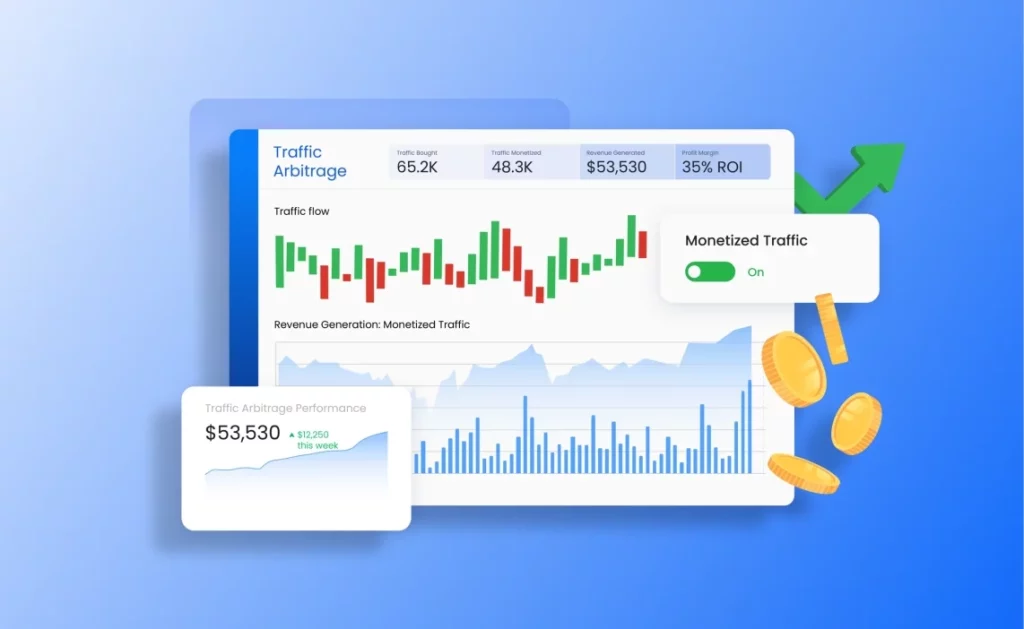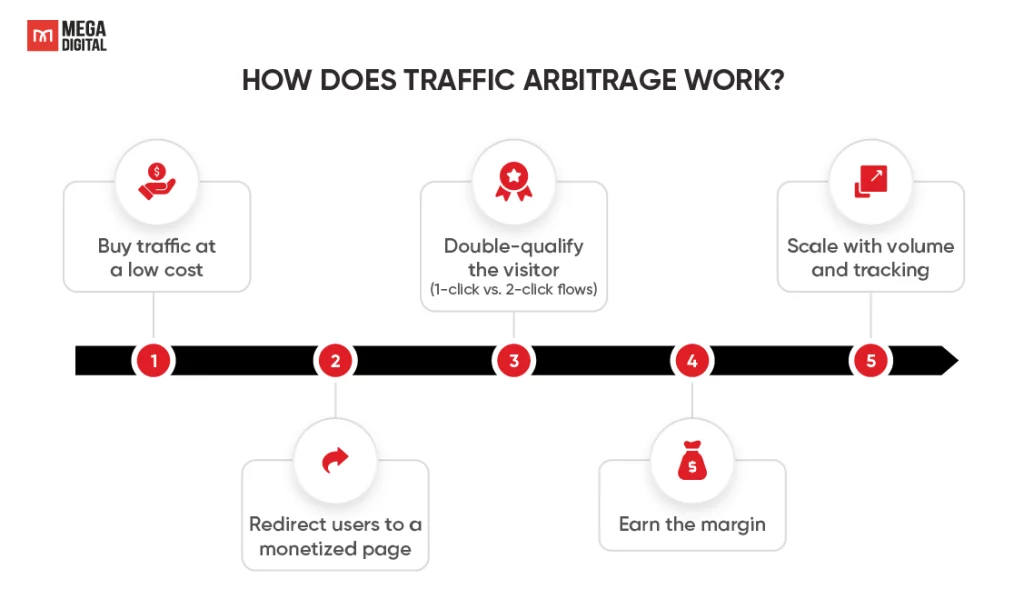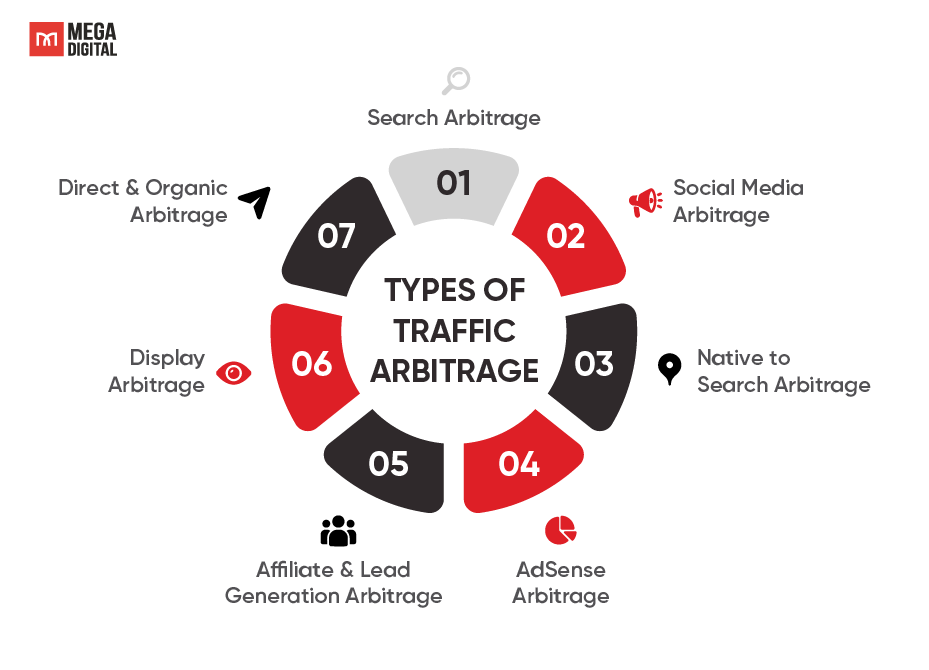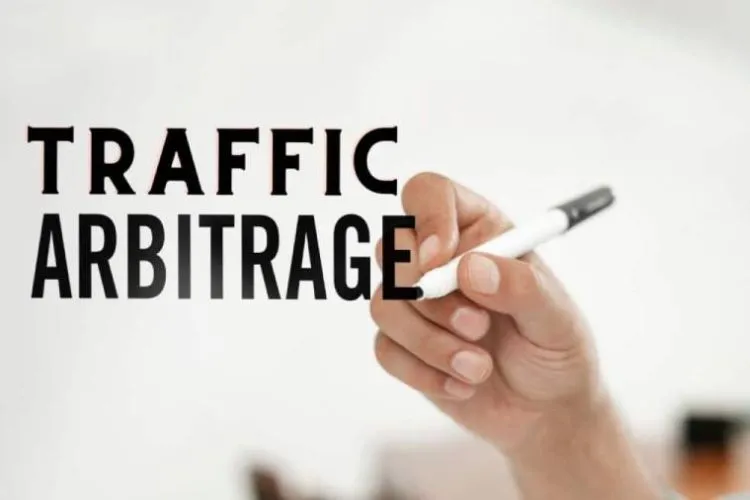Traffic arbitrage is a digital marketing model based on buying low-cost traffic and reselling it at a higher value. In 2025, this strategy includes search, social, native, and AdSense arbitrage. This guide explains how it works, the main types and traffic sources, plus best practices to run profitable campaigns.
Quick Summary
- How traffic arbitrage works (1-click vs. 2-click flows, double qualification).
- The main types — search, social, native, AdSense, affiliate, display, direct & organic.
- Best traffic sources in 2025 and how to choose them.
- Pros, cons, and risks of running arbitrage campaigns.
- Best practices to scale profitably while staying compliant.
- By the end, you’ll have a clear overview of traffic arbitrage in 2025 and practical tips to run campaigns more effectively.
What is Traffic Arbitrage?
Traffic arbitrage is a digital marketing strategy where publishers and media buyers purchase web traffic at a lower cost and redirect it to destinations that generate higher revenue. The profit comes from the margin between the cost of buying traffic and the revenue earned from monetizing that traffic.

For example:
You might buy clicks from a native ad platform at $0.02 each and send that traffic to a website monetized with Google AdSense or a feed provider. If the ads on that site pay out $0.05 per click, you earn a $0.03 profit per click.
This “buy low, sell high” principle makes arbitrage similar to trading in finance — but instead of products, you’re trading traffic.
Key elements that define traffic arbitrage include:
- Traffic acquisition: Buying visitors from sources like Google Ads, Facebook Ads, TikTok Ads, Taboola, or Outbrain.
- Monetization: Sending those visitors to pages monetized with AdSense, search feeds, affiliate offers, or CPA networks.
- Profit margin: Earning revenue when the value of each click or impression is higher than its acquisition cost.
How Does Traffic Arbitrage Work?

At its core, traffic arbitrage is about turning small price differences in web traffic into profit. The process usually follows a simple flow:
- Buy traffic at a low cost
Arbitrageurs purchase traffic from platforms like Google Ads, TikTok Ads, Facebook Ads, or native networks such as Taboola and Outbrain. - Redirect users to a monetized page
Instead of sending users directly to a final offer, the traffic is funneled through a landing page or search feed page. These pages are monetized with Google AdSense, feed providers (Tonic, System1, DomainActive, Yahoo/Bing), or affiliate offers. - Double-qualify the visitor (1-click vs. 2-click flows)
- 1-click flow: Ad → SERP-like feed page → Offer/Ad.
- 2-click flow: Ad → Pre-lander (such as a parked domain or article page) → Feed page → Offer.
The second click acts as a “qualification filter,” matching visitors with more relevant ads and improving conversion rates.
- Earn the margin
Revenue is generated when a visitor clicks on an ad or offer that pays more than the initial cost of traffic. For example, if a click costs $0.02 but generates $0.05 on the monetized page, the profit is $0.03. - Scale with volume and tracking
Because margins are small, success depends on driving traffic at scale and tracking every step. Tools like Voluum or RedTrack help analyze click costs, conversion rates, and revenue so arbitrageurs can optimize and scale only what works.
In practice, this means traffic arbitrage is less about big wins per click and more about managing high-volume, low-margin campaigns effectively. When done right, even fractions of a cent in margin can compound into significant profits.
Types of Traffic Arbitrage
Traffic arbitrage can take many forms depending on where you buy traffic and how you monetize it. Below are the most common types, each with unique advantages and challenges.

1. Search Arbitrage
- How it works: Buy clicks from search engines (Google Ads, Bing Ads) at a low CPC → redirect to a feed provider (e.g., Google AdSense, System1, Tonic) that monetizes higher-value keywords.
- Why it matters: One of the most popular and scalable methods because search traffic usually has strong intent.
>>> Read more: [Search Arbitrage Guide]
2. Social Media Arbitrage
- How it works: Buy traffic from social platforms (Facebook Ads, TikTok Ads, X/Twitter) → redirect to feed pages or AdSense-monetized sites.
- Why it matters: Social traffic is often cheaper than search, but requires compelling ad creatives to attract clicks.
>>> Read more: [Social Media Arbitrage Explained]
3. Native to Search Arbitrage
- How it works: Buy native ads from Taboola, Outbrain, or Revcontent → send traffic to search feed pages where CPC is higher.
- Why it matters: Native ads blend in with publisher content, delivering large volumes of inexpensive clicks.
>>> Read more: [Native to Search Arbitrage Overview]
4. AdSense Arbitrage
- How it works: Buy traffic from paid sources → direct it to websites monetized with Google AdSense.
- Why it matters: Easy to set up, but Google’s strict compliance rules make it risky.
>>> Read more: [Google AdSense Arbitrage: How to Earn More Profit?]
5. Affiliate Arbitrage
- How it works: Buy traffic → redirect to affiliate offers (CPS/CPA) through networks like ClickBank, CJ Affiliate, or Impact → earn a commission when users purchase a product or complete an action.
- Why it matters: Offers higher payouts than simple ad clicks, but requires precise targeting and strong conversion funnels. Success depends heavily on matching the right traffic source with the right offer.
6. Lead Generation Arbitrage
- How it works: Buy traffic → send to landing pages with lead capture forms → sell collected leads (emails, phone numbers, quotes) to advertisers in verticals like insurance, finance, or education.
- Why it matters: Can generate very high returns, especially in competitive verticals with big advertisers buying leads. However, lead quality must be strong to maintain long-term partnerships.
7. Display Arbitrage
- How it works: Buy cheap banner or display ads → funnel traffic into search or monetized landing pages.
- Why it matters: Lower entry cost, but generally lower intent than search or social.
8. Direct & Organic Arbitrage
- How it works: Redirect direct type-in traffic or SEO traffic to monetized pages.
- Why it matters: Not scalable as a paid arbitrage strategy, but useful as a supplement because organic traffic generates 100% margin.
9. Other Variants
How it works:
- Push Arbitrage – Buy cheap push notification traffic from networks (e.g., PropellerAds, RichPush) → send users to search feeds, AdSense sites, or affiliate offers.
- Email Arbitrage – Acquire or rent email lists → send traffic to monetized pages or affiliate products.
Why it matters: These are niche models compared to search or social arbitrage, but still used by affiliates who specialize in low-cost traffic channels. Push ads can drive massive volume quickly, while email can deliver high ROI if lists are engaged — though both face compliance and deliverability challenges.
Pros and Cons of Traffic Arbitrage
Like any digital marketing strategy, traffic arbitrage comes with both opportunities and challenges. Understanding the trade-offs helps you decide whether it’s the right model for you.

Pros
- Quick scalability
You can buy thousands of clicks instantly from platforms like Google Ads, TikTok Ads, Facebook Ads, or native networks, without waiting months for SEO results. - Multiple monetization options
Revenue can come from AdSense, feed providers (Tonic, System1, DomainActive), affiliate offers, or CPA networks. This flexibility lets arbitrageurs test and adapt quickly. - Flexibility in testing
Arbitrage campaigns can be launched, paused, or redirected at any time. It’s easy to test different traffic sources, niches (finance, insurance, antivirus, edu), and landing flows. - Low entry barrier for testing
Beginners can experiment with a small budget (a few hundred dollars) to validate campaigns before scaling.
Cons
- Low-margin, high-volume game
Profit per click is often just a few cents. To generate meaningful revenue, you must run campaigns at scale. - Ad account bans & compliance risks
Platforms like Google, Facebook, and TikTok have strict policies. Account suspensions can wipe out campaigns overnight. Feed providers also demand high traffic quality (TQ).
Many arbitrageurs use Mega Digital’s agency ad accounts to reduce the risk of suspension and maintain campaign stability across platforms.
- Traffic quality challenges
Cheap traffic often includes bots or low-engagement users. Poor-quality clicks lower RPM and risk getting you banned by feed providers. - Cash flow pressure
Arbitrageurs pay for traffic upfront but often wait weeks for payouts from AdSense or affiliate networks. This makes strong financial management essential. - Constant optimization required
Traffic arbitrage is not a set-and-forget model. Continuous tracking, A/B testing, and creative refreshes are necessary to keep margins positive.
Best Traffic Sources for Arbitrage in 2025
We’ve seen that traffic arbitrage offers scalability and flexibility, but also comes with challenges like low margins and strict compliance rules. The next logical question is: where should you actually buy traffic from? Choosing the right traffic sources is critical, since the quality and cost of clicks determine your profit margin.
Here are the main traffic sources to consider in 2025:
|
Traffic Source |
Why It Works |
Challenges |
Best Use Cases |
Search Engine Ads (Google, Bing) |
Highest user intent, strong ROI potential |
Higher CPC, strict compliance rules |
Search-to-Search arbitrage, finance, insurance, high-value niches |
Social Media Ads (Facebook, TikTok, Instagram, X) |
Huge reach, advanced targeting, cheaper CPC than search |
Account bans, ad fatigue, requires creative testing |
Social-to-Search arbitrage, viral content, eCommerce |
Native Ads (Taboola, Outbrain, Revcontent) |
Large traffic volume, ads blend into publisher content |
Engagement quality varies, creative-dependent |
Native-to-Search arbitrage, news/content niches |
Display & Programmatic (GDN, DSPs) |
Broad reach, often low CPM |
Lower intent, needs smart targeting |
Display-to-Search flows, remarketing campaigns |
Affiliate Networks (CJ, ShareASale, Amazon, niche offers) |
Direct access to commission-based offers |
Conversion quality depends on traffic, some networks ban arbitrage |
Affiliate & lead-gen arbitrage |
|
Email / Referral Traffic |
Can be highly targeted and cost-efficient |
Harder to scale, requires partnerships or lists |
Supplemental traffic, niche campaigns |
Emerging Channels (Push, Video Ads, Influencer) |
Cheap traffic (push, video), influencer brings niche audiences |
Push fatigue, influencer cost/fit issues |
Testing new verticals, supplementing main campaigns |
How to Profit from Traffic Arbitrage (Best Practices 2025)
Now that we’ve covered the best traffic sources, the next question is how to actually make traffic arbitrage profitable. Since margins are slim, success comes down to strategy, discipline, and constant optimization. Here are the best practices for 2025:
1. Choose the right verticals
Not all niches pay the same. High-value verticals like finance, insurance, education, antivirus, and legal services usually offer the best margins. Test multiple niches, but double down on those with higher CPC and proven demand.
2. Test and optimize aggressively
Traffic arbitrage is a numbers game. Start small with A/B testing on ad creatives, landing flows, and targeting. Track CTR, CPC, and RPM to identify profitable combinations. Scale only what works.
3. Focus on traffic quality
Feed providers (Google, Bing, Yahoo, Tonic) are strict about Traffic Quality (TQ). Avoid bot traffic or low-engagement users, as they can lead to account suspension. Use tracking tools like Voluum or RedTrack to filter and qualify traffic before sending it to feeds.
4. Manage cash flow carefully
You’ll pay for traffic upfront, but payouts from AdSense, feeds, or affiliates often take weeks. Keep enough budget to cover ad spend during this gap. Many arbitrageurs fail because they underestimate cash flow pressure.
5. Diversify traffic sources
Don’t rely on a single channel. Platforms like Google and Facebook frequently ban accounts. Spread campaigns across multiple sources (search, social, native, push) to reduce risk and stabilize income.
6. Secure reliable ad accounts
Even with the right strategy, your campaigns won’t survive if your ad accounts get suspended. This is one of the biggest risks in arbitrage
Risks and Legal Considerations
Even with the best practices in place, traffic arbitrage comes with real risks. Many campaigns fail not because the strategy is flawed, but because compliance and traffic quality are overlooked. Understanding these challenges is critical before scaling.

1. White, Gray, and Black Arbitrage
- White arbitrage: Legitimate offers and ethical promotion (e.g., finance, insurance, education).
- Gray arbitrage: Borderline industries like supplements or gambling, where compliance rules are stricter.
- Black arbitrage: Misleading ads, fake headlines, or forced redirects. While tempting, this often leads to account bans and reputational damage.
2. Ad Network and Feed Provider Policies
Google, Bing, TikTok, Facebook, and major feed providers all enforce strict ad policies. Violating these — whether through misleading creatives, non-compliant ad density, or low-quality traffic — can result in account suspension or permanent bans.
3. Traffic Quality (TQ) Requirements
Feed providers actively monitor traffic quality to prevent fraud. Sending bot traffic, incentivized clicks, or unqualified visitors can get your account blocked. High-converting, stable, human-origin traffic is non-negotiable.
4. Data Privacy and Legal Compliance
With GDPR, CCPA, and other privacy regulations, arbitrageurs must ensure proper data handling. Transparency in ad placements and respecting user consent are not optional — they’re mandatory.
5. Financial Risk
Arbitrage requires upfront investment. Because margins are slim, overspending on untested campaigns or relying on a single traffic source can quickly burn through your budget.
Final Thoughts
Traffic arbitrage remains one of the most dynamic ways to monetize digital traffic in 2025. By buying low-cost clicks and reselling them through search feeds, AdSense, or affiliate offers, marketers can generate steady profits — provided they manage margins, compliance, and traffic quality.
A winning strategy combines three pillars:
- Optimized websites and landing flows to engage visitors.
- High-quality, diverse traffic sources to reduce risk.
- Stable ad accounts to keep campaigns running at scale.
Many arbitrageurs struggle not because they pick the wrong theme or vertical, but because their ad accounts get suspended mid-campaign. That’s why working with Mega Digital’s agency ad accounts (Google, TikTok, Facebook, Bing) is often the difference between campaigns that fail fast and campaigns that scale sustainably.










